Pet Center Bundle
How Does Petz Thrive in the Booming Pet Care Market?
Petz, a leading Brazilian Pet Center SWOT Analysis, has become a major player in the pet care industry, offering a wide range of products and services. Its success is built on a strong network of physical stores and a dynamic e-commerce platform, serving a broad customer base across Brazil. In Q4 2024, Petz demonstrated its market strength with impressive financial results, highlighting its significance in the pet business model.
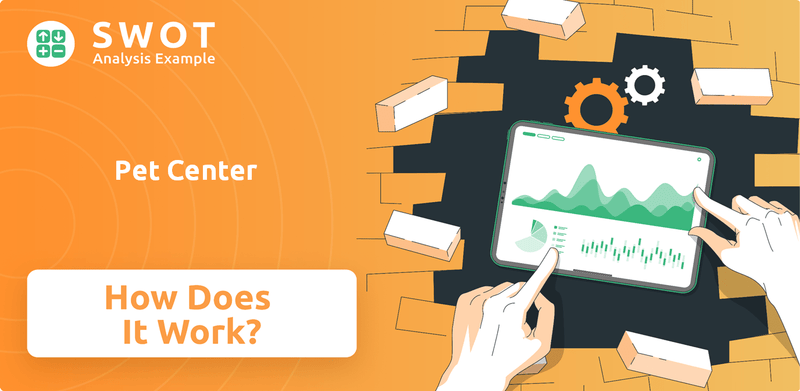
This deep dive will explore the inner workings of this pet center company, including its value propositions, revenue streams, and strategic moves. Understanding the pet store operations and its ability to adapt to the growing demand for animal care services and online shopping is crucial for investors. We'll analyze how Petz capitalizes on the expanding global pet care market, driven by increased pet ownership and the demand for premium pet product retail.
What Are the Key Operations Driving Pet Center’s Success?
The core operations and value proposition of a pet center company revolve around providing a comprehensive range of products and services tailored for pets and their owners. This includes everything from pet food and accessories to veterinary care, grooming, and adoption services. The company's business model is designed to create a 'one-stop shop' experience, aiming to meet all the needs of pet owners under one roof, fostering customer loyalty and convenience.
The company operates through a network of physical stores and a robust e-commerce platform, demonstrating a strong omnichannel approach. This integration ensures that customers can shop and access services seamlessly, whether in-store or online. The focus on customer service and the expansion of service offerings, such as pet health plans, further enhance the value proposition, making the company a preferred choice for pet owners.
By the end of 2024, the company had 262 physical stores, with 5 new stores opened between October and December 2024. The company's e-commerce platform is significant, with 92% of its digital sales fulfilled through direct shipping or in-store pickup. Physical store sales saw an 11.4% year-over-year increase in Q4 2024, while its e-commerce operations grew by 6.4%.
The company offers a wide array of products, including pet food, accessories, and private label brands. It also provides essential services such as veterinary care and grooming. This comprehensive approach ensures that pet owners can find everything they need in one place, enhancing convenience.
The company effectively integrates its physical stores with its online platform. This includes efficient logistics for both in-store and direct-to-consumer sales. This seamless integration boosts customer experience and allows the company to reach a broader audience.
The company places a strong emphasis on customer service, aiming to create a pleasant in-store experience. This focus helps build customer loyalty and encourages repeat business. The company also provides pet health plans to deepen customer connections.
The company manages a diverse supply chain to handle a wide variety of products, including its rapidly growing private label brands. In Q1 2025, private label sales increased by 31% year-over-year, accounting for over 11% of the retailer's sales. Strategic partnerships also play a crucial role.
The company's operational success is driven by its ability to integrate a wide product offering with comprehensive services, creating a holistic pet care ecosystem. This approach translates into customer convenience and loyalty, making it a leader in the pet product retail market. For more insights, you can read about the Growth Strategy of Pet Center.
- Strong growth in private label brands, with a 31% increase in Q1 2025.
- Expansion of service offerings, including pet health plans, to enhance customer relationships.
- A robust omnichannel strategy that integrates physical stores and e-commerce for seamless customer experiences.
- Strategic partnerships for brand collaborations, such as with Zee.dog, to offer unique products.
Pet Center SWOT Analysis
- Complete SWOT Breakdown
- Fully Customizable
- Editable in Excel & Word
- Professional Formatting
- Investor-Ready Format
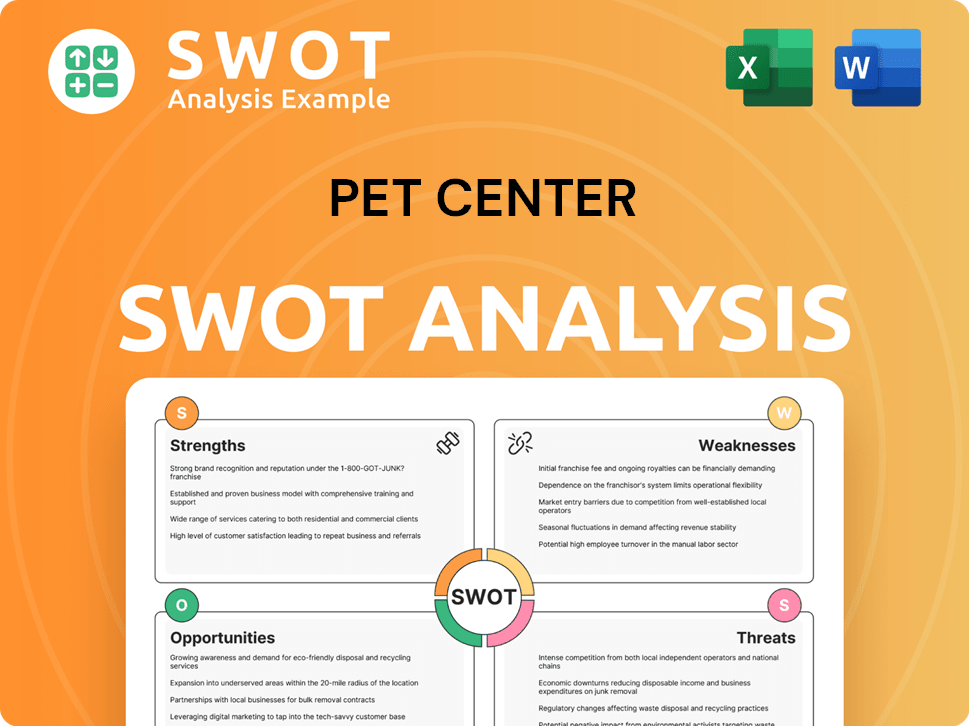
How Does Pet Center Make Money?
The [Company Name] generates revenue through a multifaceted approach, primarily focusing on product sales and services. This strategy is bolstered by innovative monetization techniques, including subscription services and private label brands, contributing to its financial growth. Understanding these revenue streams is crucial for grasping the pet center company's overall business model and its ability to thrive in the competitive pet product retail market.
Product sales are a cornerstone of the [Company Name]'s revenue, encompassing a wide array of pet-related merchandise available both in physical stores and online. Services, such as veterinary care and grooming, are also a significant and growing segment. These diverse revenue streams, combined with strategic initiatives, enable the company to maintain a strong financial performance and adapt to changing consumer demands.
In Q4 2024, the total gross revenue was up 7.4% year-over-year, reaching R$1.1 billion ($186.5 million/€172.1 million). The company's Q1 2025 revenues exceeded R$1 billion ($178 million/€160 million), marking an 8% increase compared to Q1 2024. This growth was primarily driven by a 9% increase in B2C sales revenue, which reached R$947 million ($17 million/€15 million).
Product sales include a variety of pet food, accessories, and other merchandise. These products are sold through the company's physical stores and its e-commerce platform. This is a primary source of revenue for the company.
Services include veterinary care and grooming. In Q1 2025, services and other revenues increased by 15% to R$32 million ($6 million/€5 million). The company is also launching pet health plans under Seres Saúde.
Clubz offers exclusive discounts, cashback, and personalized content across four membership tiers. In Q1 2025, Clubz added 554,000 subscribers, a 19% year-over-year increase, and accounted for 29% of total revenue.
Private label brands significantly contribute to revenue. In Q4 2024, sales surged 40% year-over-year, reaching a 12% market share. In Q1 2025, own brand products increased by 31%, accounting for over 11% of sales.
B2B revenue was down 25% to R$28 million ($5 million/€4 million) in Q1 2025. Despite this, the company's focus remains on B2C sales and services.
The company leverages data for personalized cross-channel messaging. Digital revenue saw a 737% increase from 2019 to 2021. This strategy has boosted online sales.
The [Company Name] employs several monetization strategies, including the Clubz subscription service, which offers exclusive discounts and personalized content. The company's private label brands are another significant revenue driver. For more insights into how the company approaches its marketing, check out the Marketing Strategy of Pet Center.
The [Company Name] focuses on both product sales and services to generate revenue, with innovative strategies to boost growth.
- Product Sales: This includes pet food, accessories, and other merchandise, sold through physical stores and online platforms.
- Services: Veterinary care, grooming, and pet health plans contribute to revenue growth.
- Clubz Subscription: Offers exclusive discounts and personalized content, driving subscriber growth.
- Private Label Brands: These brands contribute significantly to sales, with strong year-over-year growth.
- Digital Initiatives: Data-driven personalized messaging enhances online sales.
Pet Center PESTLE Analysis
- Covers All 6 PESTLE Categories
- No Research Needed – Save Hours of Work
- Built by Experts, Trusted by Consultants
- Instant Download, Ready to Use
- 100% Editable, Fully Customizable
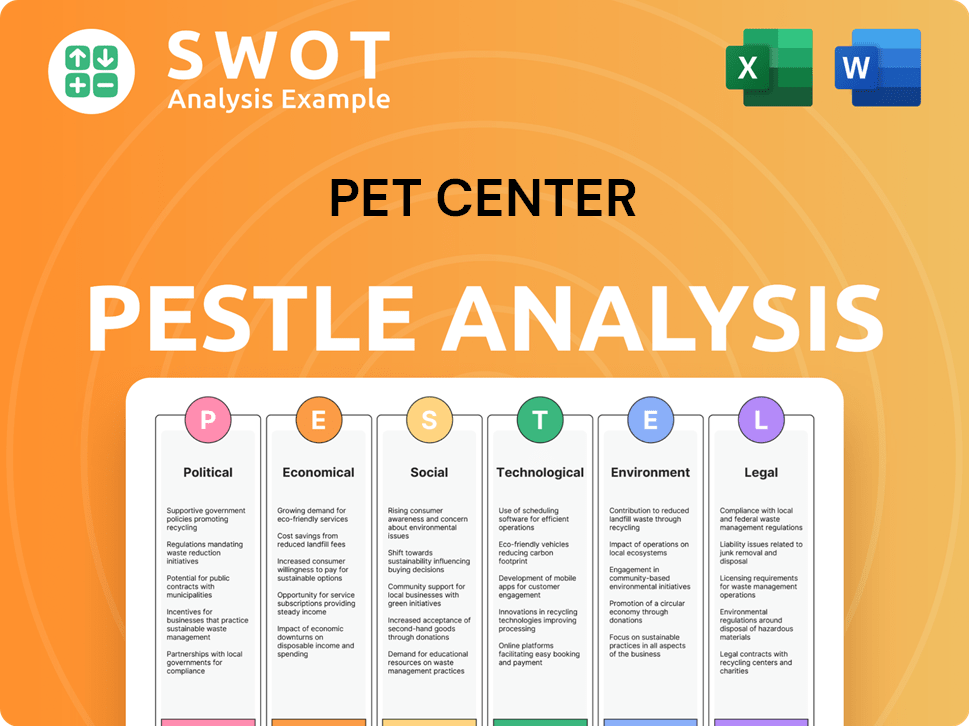
Which Strategic Decisions Have Shaped Pet Center’s Business Model?
The journey of the pet center company, Petz, showcases a strategic evolution marked by key milestones and significant moves. Founded in 2002 as Pet Center Marginal, the company quickly established itself as a pioneer by becoming the world's first 24/7 pet shop in 2003. This early innovation set the stage for future growth and expansion in the competitive pet product retail market.
A pivotal moment in Petz's development was the investment from Warburg Pincus, which facilitated brand strengthening and expansion strategies. The company rebranded as Petz and standardized its store layout, organizing navigation into 'worlds' for different pet types. The launch of its first online sales channel and the 'Vale a Pena Ser Fiel' loyalty program, a first in the pet market, were crucial steps in its omnichannel development, enhancing its pet business model.
In recent years, Petz has focused on expanding its physical footprint, reaching 262 stores by the end of 2024 across 24 Brazilian states. A significant strategic move in 2024 was the proposed merger with Cobasi, which, if approved, would create Brazil's largest pet retail company.
Petz began as Pet Center Marginal in 2002 and became the first 24/7 pet shop globally in 2003. The entry of Warburg Pincus in the capital brought new strategies. The company rebranded as Petz and implemented a standardized store layout.
The launch of its first online sales channel and the 'Vale a Pena Ser Fiel' loyalty program were crucial for omnichannel growth. In 2024, the company proposed a merger with Cobasi. The launch of pet health plans, Seres Saúde, in Q1 2025.
Petz has a strong brand presence and an extensive physical store network. The company is leveraging data for personalized customer engagement. The focus on private label development and its expansion into pet toys differentiates its product offering.
Same-store sales rebounded in Q3 2024 after four quarters of declines, with a 5.1% increase in Q4 2024. The proposed merger with Cobasi is expected to generate R$220-330 million in annual EBITDA synergies. Private label sales surged 40% in Q4 2024.
Petz's competitive advantages include its strong brand presence, extensive physical store network, and a growing digital platform that leverages data for personalized customer engagement. The company's commitment to private label development, with sales surging 40% in Q4 2024, differentiates its product offering. The launch of its pet health plans, Seres Saúde, in Q1 2025, is a strategic move to build a comprehensive 'one-stop shop' ecosystem.
- The proposed merger with Cobasi, if approved, would create Brazil's largest pet retail company.
- The company is expanding into pet toys in 2025 with 'hundreds' of new SKUs.
- Petz has demonstrated resilience in facing market challenges, with a rebound in same-store sales.
- The company adapts to new trends and focuses on a diversified product and service portfolio. To understand more about how Petz competes in the market, read about the Competitors Landscape of Pet Center.
Pet Center Business Model Canvas
- Complete 9-Block Business Model Canvas
- Effortlessly Communicate Your Business Strategy
- Investor-Ready BMC Format
- 100% Editable and Customizable
- Clear and Structured Layout
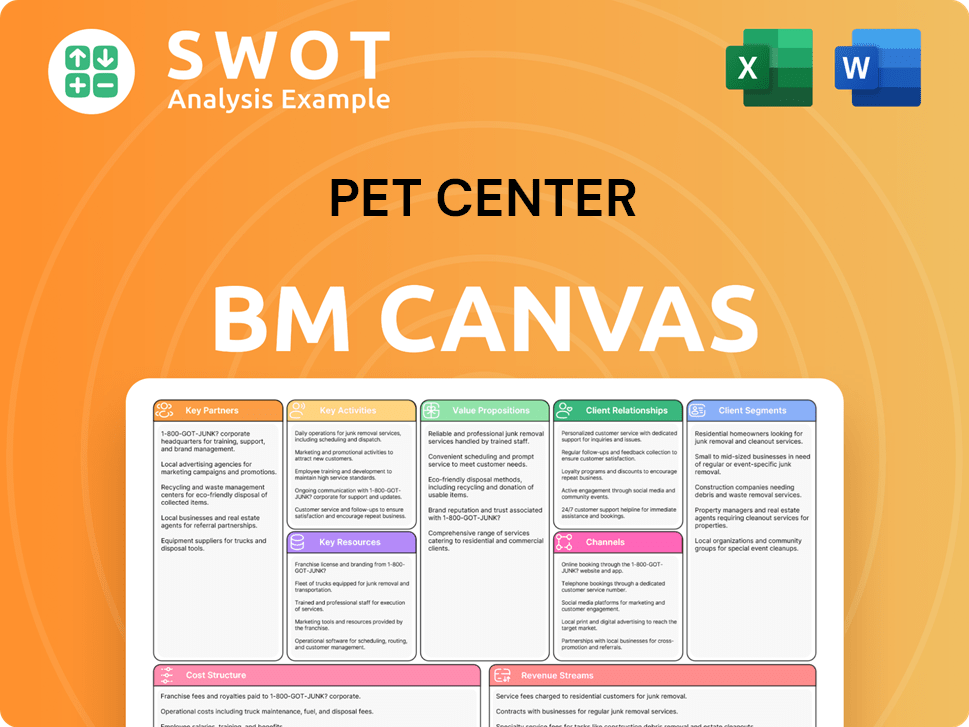
How Is Pet Center Positioning Itself for Continued Success?
The Owners & Shareholders of Pet Center holds a significant market position as a leading pet retailer in Brazil. Its extensive network of physical stores and a robust e-commerce presence are key to its success. By the end of 2024, the company operated 262 stores across 24 Brazilian states. The proposed merger with Cobasi, if approved, would create Brazil's largest pet retail company.
Despite its strong market position, the company faces several risks. Increased competition from online marketplaces poses a challenge. Economic uncertainties, such as inflation and fluctuating consumer spending, could impact demand. Operational risks include managing a large supply chain and maintaining efficiency across its diverse offerings.
The company is a leading pet retailer in Brazil, with a strong presence in both physical stores and online. The proposed merger with Cobasi would solidify its dominance. This strategic consolidation aims to enhance market share and customer loyalty in a growing market.
The company faces increased competition from online marketplaces. Economic uncertainties, such as inflation, could impact demand. Operational risks include managing a large supply chain. These factors could affect profitability and growth.
The company aims to continue its physical store expansion, with approximately 40 new store openings projected for fiscal year 2025. It is also heavily investing in its private label brands. The expansion of its pet health plans is a key strategic initiative.
Expansion of physical stores, with approximately 40 new store openings projected for fiscal year 2025. Launching 'hundreds' of new SKUs in 2025, especially in the pet toy segment. Expanding pet health plans, Seres Saúde, to deepen customer engagement. Leveraging technology, including AI, for personalized customer experiences and operational efficiency.
The company anticipates continued growth, with an expected revenue between $1.17 billion and $1.20 billion for fiscal year 2025. The Brazilian pet market generated over R$60 billion in revenue in 2022. The proposed merger aims to achieve a combined annual revenue of R$6.9 billion.
- Continued physical store expansion with approximately 40 new store openings in 2025.
- Investment in private label brands with plans to launch 'hundreds' of new SKUs in 2025.
- Expansion of pet health plans, Seres Saúde.
- Leveraging technology, including AI, for enhanced customer experiences and operational efficiency.
Pet Center Porter's Five Forces Analysis
- Covers All 5 Competitive Forces in Detail
- Structured for Consultants, Students, and Founders
- 100% Editable in Microsoft Word & Excel
- Instant Digital Download – Use Immediately
- Compatible with Mac & PC – Fully Unlocked
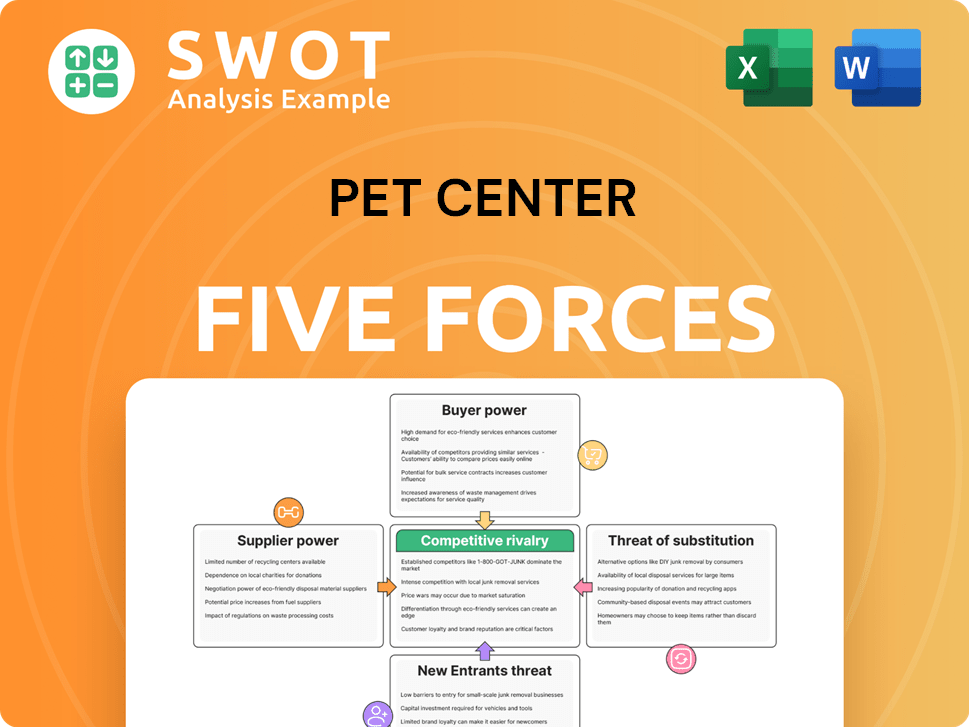
Related Blogs
- What are Mission Vision & Core Values of Pet Center Company?
- What is Competitive Landscape of Pet Center Company?
- What is Growth Strategy and Future Prospects of Pet Center Company?
- What is Sales and Marketing Strategy of Pet Center Company?
- What is Brief History of Pet Center Company?
- Who Owns Pet Center Company?
- What is Customer Demographics and Target Market of Pet Center Company?
Disclaimer
All information, articles, and product details provided on this website are for general informational and educational purposes only. We do not claim any ownership over, nor do we intend to infringe upon, any trademarks, copyrights, logos, brand names, or other intellectual property mentioned or depicted on this site. Such intellectual property remains the property of its respective owners, and any references here are made solely for identification or informational purposes, without implying any affiliation, endorsement, or partnership.
We make no representations or warranties, express or implied, regarding the accuracy, completeness, or suitability of any content or products presented. Nothing on this website should be construed as legal, tax, investment, financial, medical, or other professional advice. In addition, no part of this site—including articles or product references—constitutes a solicitation, recommendation, endorsement, advertisement, or offer to buy or sell any securities, franchises, or other financial instruments, particularly in jurisdictions where such activity would be unlawful.
All content is of a general nature and may not address the specific circumstances of any individual or entity. It is not a substitute for professional advice or services. Any actions you take based on the information provided here are strictly at your own risk. You accept full responsibility for any decisions or outcomes arising from your use of this website and agree to release us from any liability in connection with your use of, or reliance upon, the content or products found herein.